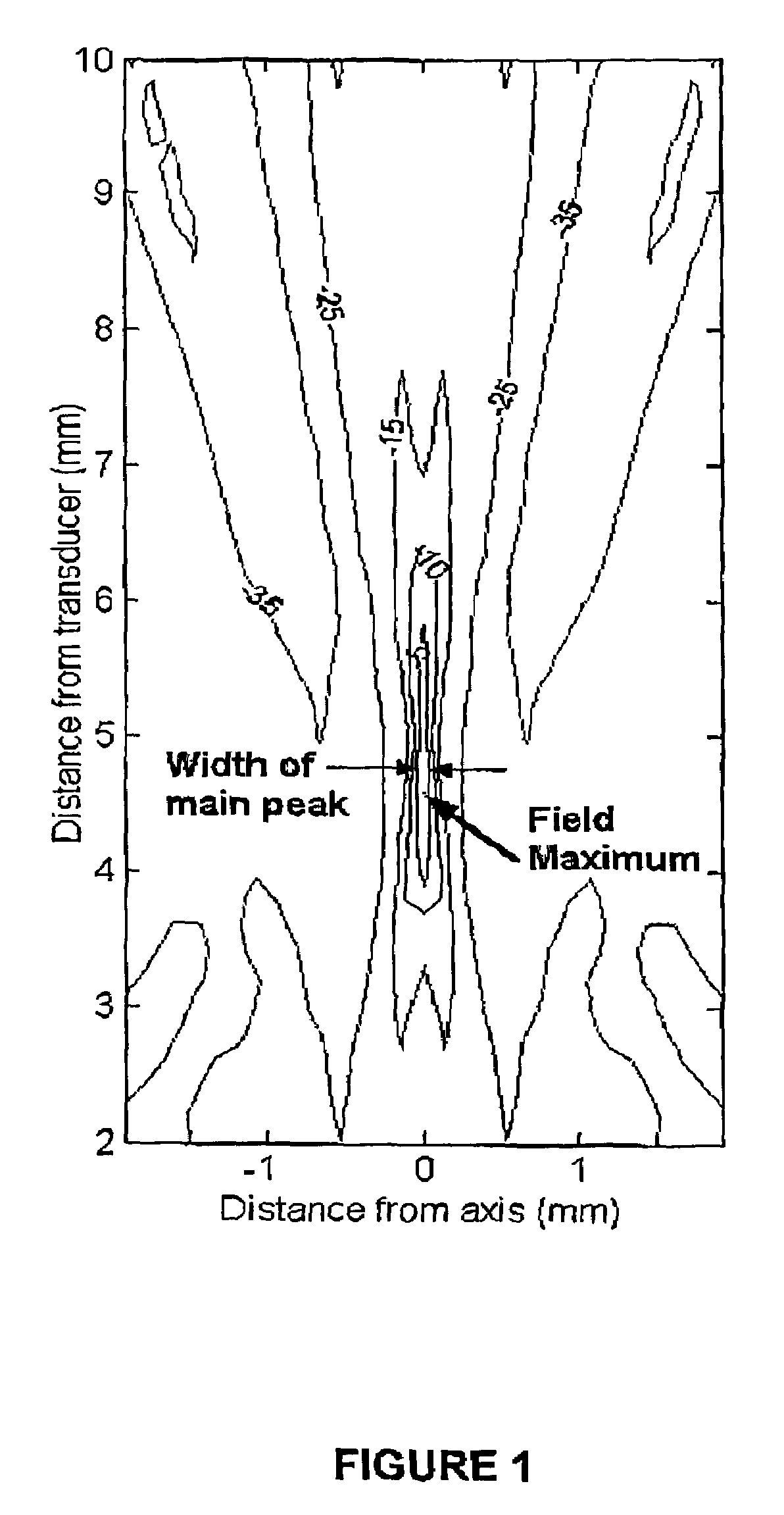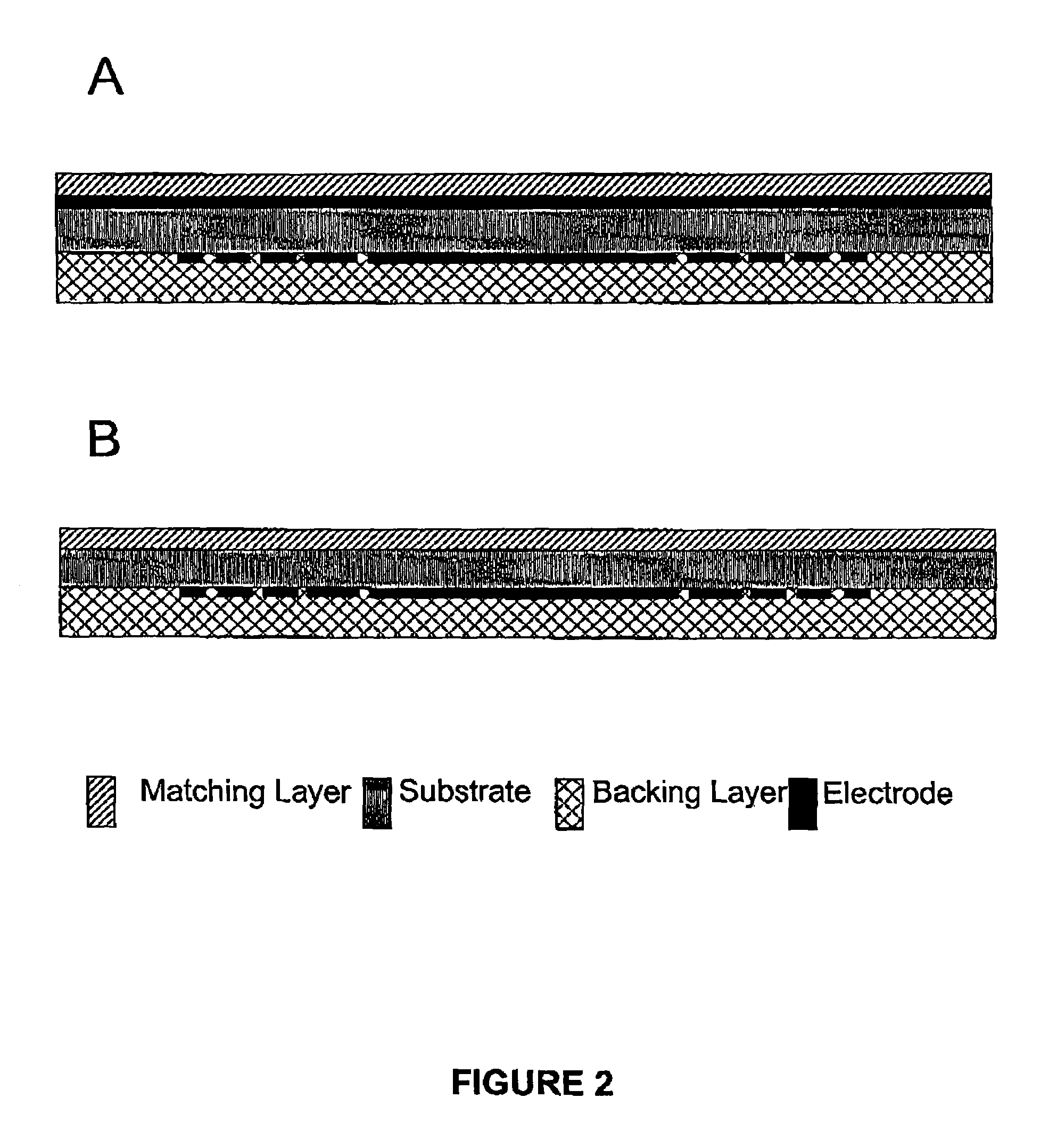Ultrasound transducer array
a transducer array and ultrasonic technology, applied in the field of ultrasonic transducers, can solve the problems of unwanted energy transmission and reception, destructive and interference of signals transmitted to (or received from) the desired region of spa
- Summary
- Abstract
- Description
- Claims
- Application Information
AI Technical Summary
Benefits of technology
Problems solved by technology
Method used
Image
Examples
example 1
[0051]With reference to FIG. 2B, a high frequency (50 MHz) transducer array comprises a PZT substrate (Motorola 3203HD) having a thickness of approximately 47 μm. An electrode layer of Cr—Au about 1000 Å thick is deposited on the first face of the substrate. An electrode layer of aluminum about 2 μm thick is deposited on the second face. The second face or electrode is patterned using photolithography to define the array geometry as shown in FIG. 3, which figure depicts an electrode pattern suitable for a 50 MHz annular array. A matching layer of silver epoxy at a thickness of approximately 9 μm is applied to the first face of the array. Electrical connections are made to the array elements and a backing layer of tungsten-loaded epoxy (EPO-TEK 301-2), at a thickness of approximately 1 mm, is applied to the second face of the array.
[0052]The performance of several embodiments of a 50 MHz kerfless annular array was evaluated using a finite element model (FEM) (PZFlex, Weidlinger Assoc...
example 2
[0056]The performance of 50 MHz kerfless and sub-diced arrays was evaluated using finite element modeling (PZFlex, Weidlinger Associates, Calif.). Both arrays had 64 elements, 30 μm element spacing, a single front quarter-wavelength matching layer, and a high loss, high impedance backing layer. No kerf filler was used for the diced array and each element was sub-diced once to suppress lateral modes. The −6 dB width of the directivity (single element) calculated at a 5 mm radius was 16 degrees for the kerfless array, compared with 72 degrees for the sub-diced array. Cross-talk between adjacent elements was −7.5 dB for the kerfless array, and −28 dB for the sub-diced array. As shown in FIG. 7, the radiation pattern (5 mm focal distance) had a −6 dB width of 1.5 degrees for both arrays. At an angle of 7.5 degrees, the radiation pattern was below −60 dB for both arrays. The pulse shape and pulse amplitude at the focal region were remarkably similar for both arrays.
[0057]The finite eleme...
example 3
[0058]A hybrid linear-linear phased array is shown schematically in FIG. 8, based on a substrate 10, where the phased array portion is a conventional diced array with half-wavelength spacing and a kerf filler 20 between elements, and with the electrodes 15 on the top face of the transducer. On the bottom face of the transducer, electrodes 25 are patterned perpendicular to those of the phased array, creating a kerfless linear array.
[0059]The hybrid array is made from the same materials as described previously (e.g., PZT substrate, chrome-gold electrodes, tungsten-loaded epoxy backing layer, one or more polymer matching layers), and the geometry of the elements is preferably rectangular. The linear phased array elements has an aspect ratio (height / width) of at least 2 to avoid coupling unwanted lateral modes into the bandwidth of the array. The linear array elements have about ½ to about 2 wavelength spacing, with a gap of about 5% to about 30% of the element width between adjacent el...
PUM
| Property | Measurement | Unit |
|---|---|---|
| radius | aaaaa | aaaaa |
| frequencies | aaaaa | aaaaa |
| frequencies | aaaaa | aaaaa |
Abstract
Description
Claims
Application Information
 Login to View More
Login to View More - R&D
- Intellectual Property
- Life Sciences
- Materials
- Tech Scout
- Unparalleled Data Quality
- Higher Quality Content
- 60% Fewer Hallucinations
Browse by: Latest US Patents, China's latest patents, Technical Efficacy Thesaurus, Application Domain, Technology Topic, Popular Technical Reports.
© 2025 PatSnap. All rights reserved.Legal|Privacy policy|Modern Slavery Act Transparency Statement|Sitemap|About US| Contact US: help@patsnap.com



